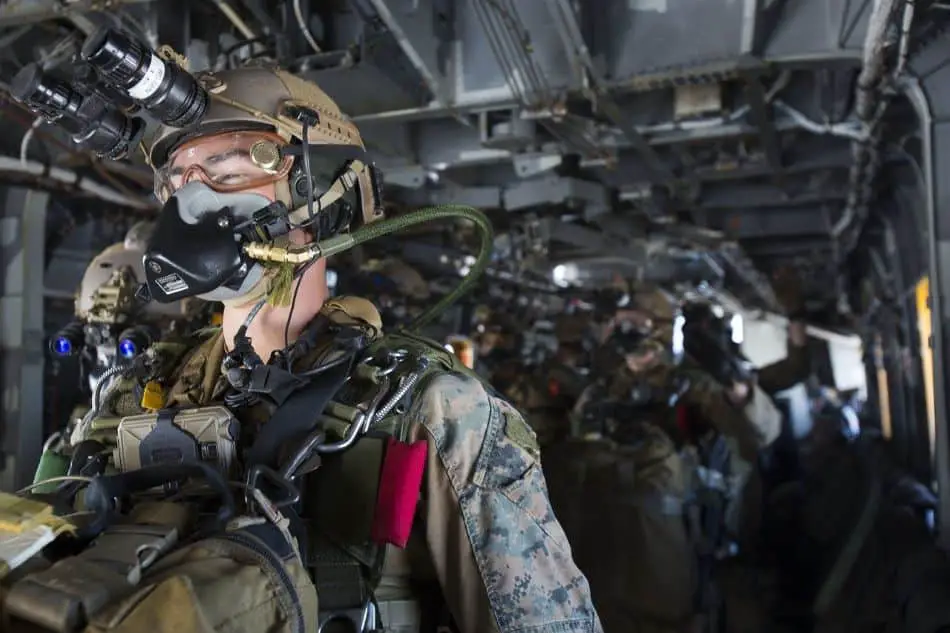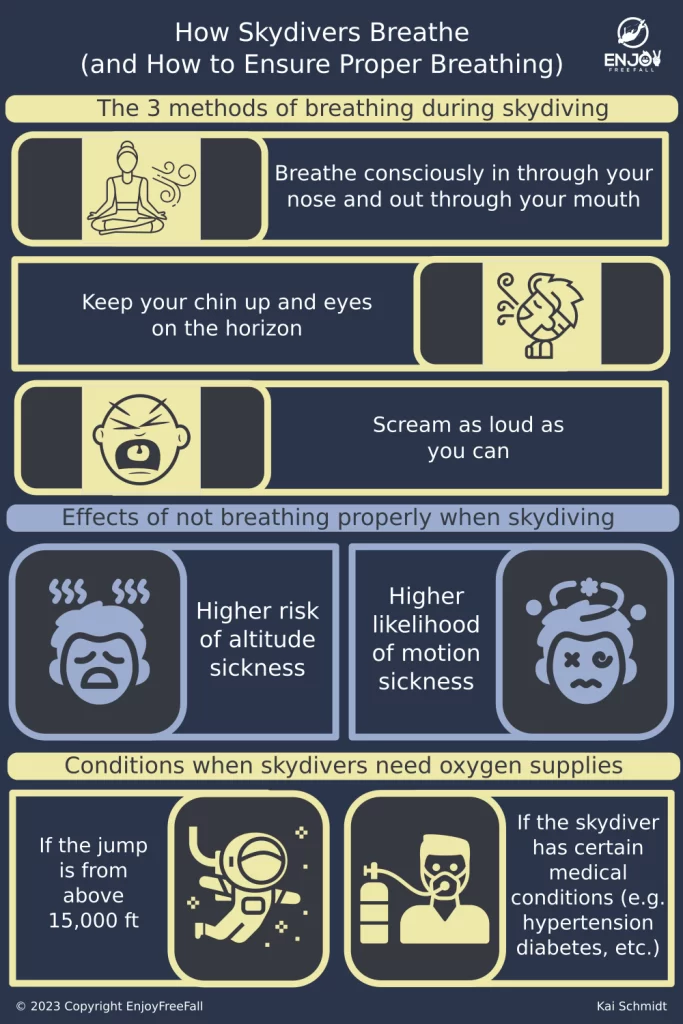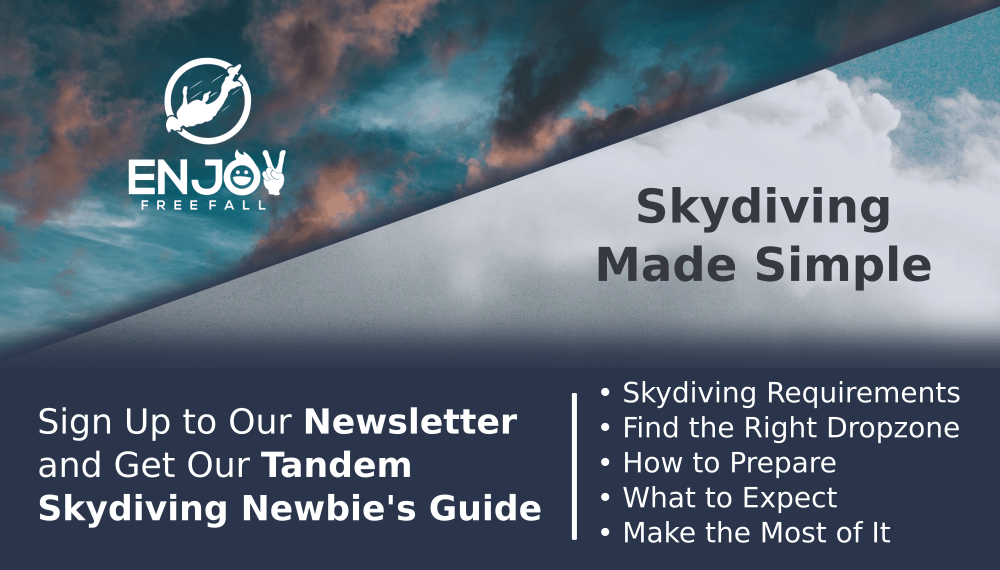
Jumping out of an airplane for the first time while being strapped onto a tandem instructor and free-falling at a speed of 120 mph can literally take your breath away. Which then begs the question, how do skydivers breathe during skydiving?
Skydivers can breathe normally during skydiving as long as they jump from below 15,000 ft. For jumps above 15,000 ft, skydivers need to use oxygen supplies. First-time skydivers sometimes also experience difficulties breathing because their whole body tightens up and they forget to breathe.
The scariest part of skydiving is not the physical activity, but the fear of the unknown. Achieving great things in life comes with embracing your fear and deflating it. Leaping faith during skydiving can be scary but exciting at the same time.
In the following, I explain three methods how you can breathe normally as a first-time skydiver. I also show when skydivers need oxygen supply.
Why Do First Time Skydivers Have Difficulty Breathing?
First-time skydivers normally deal with a lot of nervous energies before the jump. People tend to overthink, especially if they are doing things for the first time.
As the plane goes up, your body produces a lot of energy and adrenaline and some people tend to hold their breath. It is normal that people hold their breath and forget to breathe when they face something scary. Skydiving is not different specifically because it involves high altitudes.
The breath can also become more shallow before the jump. This is caused by the increased level of adrenaline in our bloodstream. Adrenaline causes the airways to relax to quickly give more oxygen to the muscles (which will become stronger with more oxygen). As a result, we do not breathe in as deep as we usually do.
In order to release the tension and nervous energies during a nerve-wracking activity, you need to consciously take a deep breath in and exhale as you step out of the aircraft.
The oxygen level at around 10,000 to 15,000 ft. is 40 percent lower compared to the concentration on the ground. However, there will be no shortness of oxygen at this height, as there is enough supply to support normal breathing.
In general, skydiving has incredible effects on the human body beyond increased levels of adrenaline. If you want to know more about them, check this article out.
Three Methods of Breathing During Skydiving
Student jumpers experience difficulty in breathing because they simply forget that they can breathe. Here are three ways you can breathe as you exit the plane and embark on the 120 mph free fall.
Breathe Consciously in Through Your Nose and Out Through Your Mouth When Skydiving
Just like with any other strenuous activity or sport, you can focus on your breath and consciously breathe in through your nose and out through your mouth. This is a great way to relax your entire body and use the right amount of energy so that you do not get tired easily.
You can practice this before your skydive. When riding as a passenger in a moving car, try to stick your head out of the window to experience the 60 mph speed. It is not so different from being on a freefall at a speed of 120 mph. Breathing then can be challenging because the strong wind is hitting your face, but it is doable as long as you focus on it.
Keep Your Chin up and Eyes on the Horizon When Skydiving
If you look down, you might inhale too much wind during the free fall. To avoid that, it is recommended to keep your chin up so that the 120 mph wind will only hit your neck and the bottom of your chin. It will be much easier to breathe since the wind is not rushing towards your face.
Another good way to keep your chin up is to fix your eyes on the horizon. It is the perfect time to appreciate the beauty of the view. It is a good distraction and reward from such a nerve-wracking experience. Most skydive centers have beautiful landscapes and majestic sceneries.
If you are looking for great scenery during your canopy ride, make sure to read my article revealing the 15 best and most memorable wingsuit locations worldwide. Even though the article focuses on wingsuit spots, you can often go skydiving there as well!
Scream as Loud as You Can When Skydiving
This is the most common advice of tandem instructors to their students. If you do not know what to do, especially when panic kicks in, just scream as loud as you can. Screaming will help you release the energy and adrenaline surge. Once that tension is released, your body will feel more relaxed and you can fully enjoy the entire skydiving experience.
It can kick start breathing and will remind you that it is not difficult to breathe in the air as you free fall. It’s like riding on a roller coaster. Screaming on top of your lungs will help you enjoy the whole ride. Once the 40- 60 seconds dive is over, you will find it easier to breathe and even talk to your instructor while under the canopy and enjoying the view.
Would you like to know how skydiving can boost your confidence and help you channel your fear into something thrilling? Make sure to read my post about the 7 reasons to skydive when being scared of heights. It will motivate you to take the leap!
Speaking of roller coasters, if you would like to dive deeper about whether the feelings of skydiving and riding a roller coaster are the same, read my dedicated article about it here. I also explained which activity is scarier and more dangerous – you’d be surprised by the answers.

Effects of Not Breathing Properly When Skydiving
Not breathing properly during skydiving at high altitudes can have physical and mental effects on beginners, as well as experienced skydivers. Here are some things that might happen in case you forget to breathe, and some helpful workarounds.
Altitude Sickness Can Be Caused by Improper Breathing During Skydiving
Altitude sickness, also called Hypoxia, is caused if someone stays at a high altitude for an extended period of time without sufficient oxygen supply to their brain and body. This could result in passing out, or blacking out during the free fall or canopy ride.
Fortunately, altitude sickness is not so common in skydiving, because the FAA set the ideal height for tandem jumping and solo skydiving at between 10,000 and 15,000 ft. At this height, there is sufficient oxygen to facilitate proper and normal breathing. Also, only a short time is spent at this altitude, since you will be descending at a speed of 120 mph, which is enough to get you to the parachute deployment height in just about 40- 60 seconds.
In case a tandem jumper blacks out due to lack of oxygen, they will miss out on the canopy ride, and it will also be difficult for the tandem instructor to manage their body position under the canopy and during landing. However, students will still arrive at the dropzone safely.
If solo skydivers blackout during their jump, their automatic deployment system will activate the parachute at a preset altitude. However, it is still not guaranteed that the parachute deploys properly because the skydiver might spin around uncontrolled before the deployment.
If the parachute deploys properly, the solo skydiver is still likely to be drifted apart from the designated dropzone and get injured during the uncontrolled landing. That being said, it is very unlikely for solo skydivers to blackout during their skydive.
Did you know that besides saving the skydiver’s life in many situations, there are other reasons to wear a skydiving helmet? Read my article about it here where I also went in detail about the different types of skydiving helmets, as well as the different provisions for it.
Motion Sickness Can Be Caused by Improper Breathing During Skydiving
Some people may experience motion sickness as a result of insufficient oxygen supply, resulting in headaches, nausea, or dizziness. So if you are prone to motion sickness, here are a few tips on how to prepare for your big day.
On the night before skydiving, your heart and mind will be racing with excitement, making it challenging to get some decent sleep. However, to avoid getting motion sickness and ruining the skydiving experience it is recommended that you try to get plenty of rest so that you have energy throughout the day and maintain optimal physical and mental performance.
There are also instances where first-time skydivers pass out under the canopy, not because of fear or difficulty in breathing, but due to dehydration and not eating properly before the jump. It is therefore highly recommended to have a balanced meal at least an hour or so before your scheduled appointment. However, do not overindulge since you might throw up during the jump.
It is also advisable to pack some light snacks and to stay hydrated while waiting for your turn to jump. Stop by a drug store or pharmacy and purchase a non-drowsy motion sickness patch or pill in case you’ll need it.
If motion sickness hinders you from skydiving, yet you yearn for adrenaline-high and exhilarating activities, I have a dedicated article featuring 13 alternative activities to skydiving. These activities are guaranteed to get your heart racing and take you to the edge of your comfort zone, offering an experience akin to skydiving’s excitement.
Conditions When Skydivers Need Oxygen Supplies
Tandem and solo jumping usually do not require oxygen support. However, some instances require oxygen supplies. A few cases are listed below.
Skydivers Need to Wear Oxygen Supply if the Jump From Above 15,000 FT
As per the FAA regulations, passengers are required to wear oxygen supplies if they are exiting from a height of 15,000 ft. above the sea level. This is because the oxygen consistency at that level is thinner, and might result in serious hypoxia and decompression sickness.
Even though some experienced skydivers could jump from a height of 16,000 ft. without oxygen support they are not allowed to do so because it is too risky and a limit needed to be set at some altitude.
If skydivers go even higher and perform High Altitude Low Opening (“HALO”) jumps they must wear special equipment in addition to the oxygen supply. This might include specialized jumpsuits that provide skydiver not only with oxygen but also protects their body from the cold as they speed up to the ground.
For example, on 24th October 2014, Google’s Senior Vice President, Alan Eustace, made a stratosphere jump and set a new exit altitude record of 135,898ft (41,422 m) with help of a helium-filled balloon and a pressure suit that had a life support system (including oxygen supply) in it.
If you want to know about the highest altitude that people can jump from including whether it is possible to jump from space to earth, check out this article.
Skydivers With Certain Medical Conditions Need to Wear Oxygen Supply
Contrary to common beliefs, people with pre-existing medical conditions such as high blood pressure or diabetes can also participate in the sport – as long as their cases are well managed.
They need to contact a health care provider, who understands the risk of skydiving and secure a medical clearance. As soon as they have a green light from a doctor, it’s recommended that they use the oxygen equipment. Wearing an oxygen supply reduces the risks drastically for people with diabetes and high blood pressure.
Once medical clearance is received, it is important to inform the skydive center in advance such that it can check whether oxygen supply is available.
In conclusion, you can breathe and you should never forget to breathe when skydiving. Proper breathing will help you to savor the experience and not miss out on exciting moments during the 120 mph free fall.
Enjoy your free fall!




